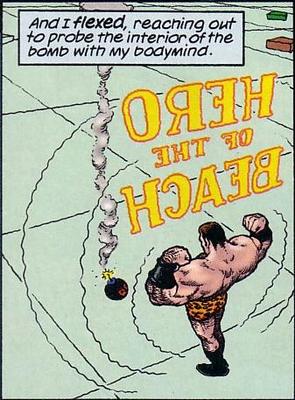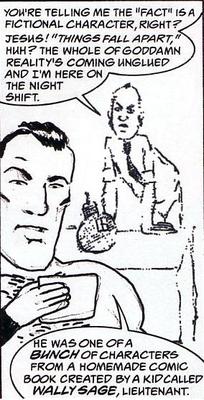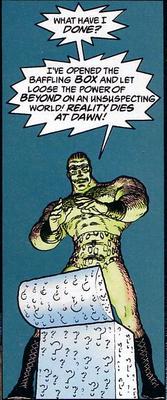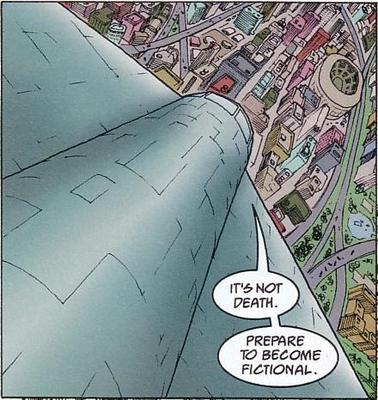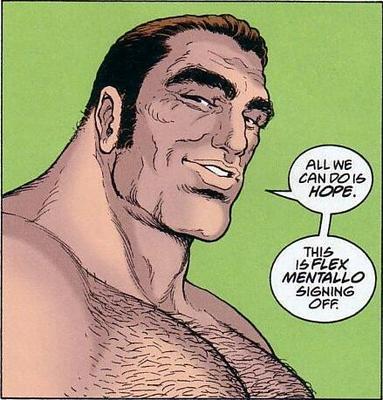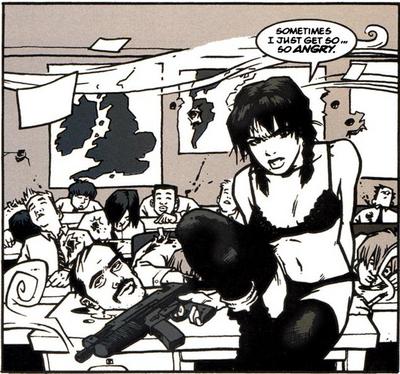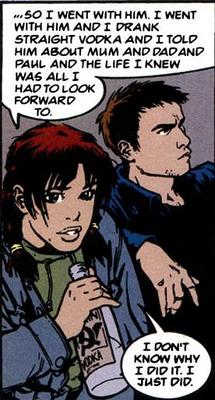Amusing and bemusing rants and raves. Unabashed tomfoolery. An imaginary audience.
Sunday, July 31, 2005
Monday, July 25, 2005
Haiku Achoo
The English Prime Minister?
Overlord of Doom!
A monstrous lizard.
The behemoth from Japan.
Oh no! Godzilla!
A monkey in space.
Rocketing through nebulas.
His name is Bojo.
Let's go to the hop.
A shindig or hootnanny?
Joanie loves Chachi.
I wrote this poem.
Five, seven, five syllables.
I haiku. Do you?
Tuesday, July 19, 2005
Remembering Jim Aparo
 Jim Aparo died less than twenty-four hours ago, at the age of 72. I'd say he was one of the most underrated artists in comics... he was a highly capable workhouse who drew some damn fine comics. His work was sharp and crisp, but sturdy and solid. His heroes were carved out of granite, and his work was infused with an understated power, an intensity hidden within the lines. He pencilled, inked, and even lettered an awful lot of fine comics.
Jim Aparo died less than twenty-four hours ago, at the age of 72. I'd say he was one of the most underrated artists in comics... he was a highly capable workhouse who drew some damn fine comics. His work was sharp and crisp, but sturdy and solid. His heroes were carved out of granite, and his work was infused with an understated power, an intensity hidden within the lines. He pencilled, inked, and even lettered an awful lot of fine comics.For a lot of us, Aparo probably did the definitive Batman. I wouldn't say he was my favorite Batman artist, but his Batman was one of the first I'd encountered and I loved his work as a kid, and greatly appreciate it today. He also did, for some of us, the definitive Aquaman and Spectre.
He was also there, pencil at the ready, for humongous events. When the general public voted to kill off Robin? He drew it. When the third Robin, Tim drake, was introduced? He drew it. When Batman's back was broken? He drew it. When Aquaman's infant son died? He drew it. When Batman joined the Outsiders? He drew it. When Batman teamed up with every single character in the DC Universe, every month in the pages of Brave and the Bold? He drew it.
Hell, he was even held hostage by super-villains once! (Image courtesy of Mile High Comics)
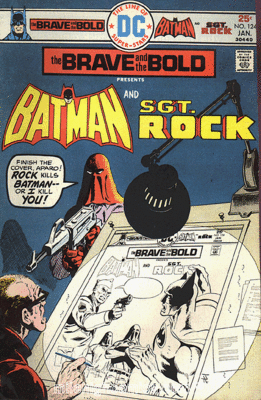 He was cool. And now he's gone. He'll be missed.
He was cool. And now he's gone. He'll be missed.So it goes...
Monday, July 18, 2005
Twelve Days Later...
And DC has finally decided to do the right thing and publish the third volume in the Doom Patrol trade paperback series, so we have extra Morrison goodness to look forward to in October (don't forget the Arkham Asylum Anniversary Edition Softcover, either). It includes the first appearance of Flex Mentallo (he's even mentioned in the solicit!), so hopefully this is a sign that they'll put the Flex series in trade. We can only hope. (Yeah, so I talk about Grant Morrison comics a lot. Um... I'm sure I'll get around to some other author's work eventually.)
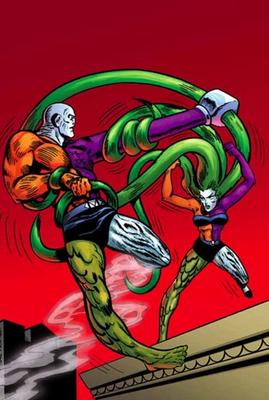 You might be able to expect another "Doom Patois" column from me once volume two arrives in the mail. It'll be posted here if it's extra-long, probably, although it may show up on CSBG. I haven't decided. Maybe I won't even get around to writing it.
You might be able to expect another "Doom Patois" column from me once volume two arrives in the mail. It'll be posted here if it's extra-long, probably, although it may show up on CSBG. I haven't decided. Maybe I won't even get around to writing it.Also in October, weird and obscure DC superhero Metamorpho is getting a massive black-and-white Showcase retrospective omnibus collection, detailing his Silver Age adventures. Could be a lot of fun, and at least a nice look at Ramona Fradon's art. Hopefully these Showcase volumes continue, especially for more obscure properties, because I'd love an Arnold Drake Doom Patrol one, or an Elongated Man collection. And eventually, I hope they get around to 70's Kirby, because that stuff was brilliant. I'm very glad DC's got around to putting out cheap, black-and-white collections of older material, akin to Marvel's "Essential" line. I can see myself buying an awful lot of these (whereas the Marvel stuff doesn't interest me too much, outside of Thor and Fantastic Four).
Wednesday, July 06, 2005
More Muscle Mystery

Tuesday, July 05, 2005
Why I Believe in Superheroes
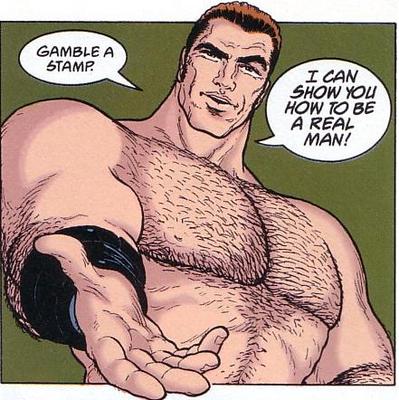
Anyway, the superheroes. I agree with my pal and fellow mad writer Andrew M. Dean's statement: "Superheroes are the greatest literary invention of the 20th century." I've found myself repeating that a lot, mainly because it is utterly true and should be shouted from the rooftops. Other writers might find it a bit silly that quite a few people think of superheroes as a modern mythology, but not I. No, I think the idea of the superhero, and quite a few executions of that idea, are primal representations of humanity’s spirit, dreams, dignity, and all that good stuff. The superheroes were born out of the cultural zeitgeists of their times, and plucked from the archetypal Jungian soup of our collective unconscious (if you believe in that sort of thing). I think that the comic book is a wonderful medium, the ultimate collaborative art form and a powerful storytelling method that’s gotten a bit lost in the corporate shuffle. Still, if there’s one thing comics do best (well, one of many things), it’s superheroes.
No other comic teaches this lesson better than Flex Mentallo, a four issue mini-series from 1996 by Grant Morrison and Frank Quitely (the same two that brought us JLA: Earth 2, New X-Men, We3, and soon, All Star Superman). It is the ultimate love letter to superheroes and the comics art form. It was also the subject of a lawsuit against DC/Vertigo by the Charles Atlas people, because, well, the character of Flex Mentallo (who first appeared in an issue of Morrison’s Doom Patrol) is, in its basest form, a parody of the old Charles Atlas bodybuilding ads. Anyway, DC won the case but has shied away from reprinting Flex in a trade paperback, so the comic is dreadfully rare and obscure. It sells for lots of money on eBay relatively regularly though, so buy it if you’ve got the bucks. If you don’t, you can always download it (“But remember kids, downloading comics is wrong!”).
Before I begin, I’d like to mention that you can find annotations for Flex by clicking here, but they probably won’t do you much good if you don’t have the book itself.
Now, what’s the comic about, you ask? Well, that’s... complicated. It would take me pages and pages to explain and analyze this comic fully, and it still won’t be worth it if you don’t have access to the book, which most people, sadly, do not. The book is an experience. It broke my brain and changed my view of the world and my writing. So, yes, it’s profound, and profoundly important to me personally. In this limited blog space, hopefully I’ll be able to cover the basics, talk it up a bit, throw some panels at you (remember: copyright, Morrison, Quitely, DC/Vertigo, etc.), and get you interested in seeking it out, that is, if it ever comes out in TPB form.
Flex Mentallo covers quite a few myriad plot threads which are all connected and all come together by the end, literally and thematically and all that. Part of it is about Flex Mentallo 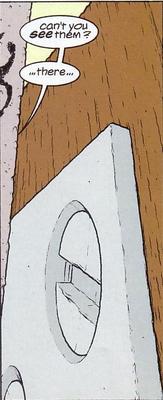
It’s a post-modern, fairly self-aware comic. It tells an adventure of the character Flex Mentallo while flashing back to his past, fictions within fictions. Meanwhile, Wally Sage’s life is flashing before his eyes, and we visit his past, his memories of the past, his dreams, and his hallucinatory acid trips. The reader is never quite sure what timeline or reality the narrative is taking place in, but that doesn’t quite matter to the plot. I’ll let the introduction from the annotations site explain further:
“Grant Morrison and Frank Quitely's Flex Mentallo, on the other hand, does not place its heroes within a novelistic or realistic world--a linear world--but rather within a fragmentary matrix of parallel universes and alternate realities, within a wild and meta-aware history of comics itself. Flex Mentallo is a comic about comics; it revels in the traditions of superhero comic books--narrative, semiotic, and corporate alike--even as it critiques them. It is an absolutely brilliant work, but it is, in many ways, an ‘inside joke.’”
To understand the book, one really has to have experience with superhero comics history. Each issue seems to be structured akin to a different comics era. There is the Silver Age issue, the Grim-and-Gritty issue, etc. The comic is at times a pastiche of superhero comics, but it’s also a loving tribute to them, filled with homages and references.
Yet, as we read, we never know what is “real,” what is a “fiction.” In truth, it is all of the above all at once. In the final issue, and I’m going to spoil a bit of the magic for you, if you don’t mind, Flex Mentallo battles the Man-in-the-Moon, who turns out to be the disillusioned teenage Wally Sage. At the same time, the adult Wally Sage is traversing his own psyche, through parallel worlds of being. He decides, in the end, that he never took any drugs, that they were, in fact, M&Ms, and so saves himself just as Flex Mentallo is *also* saving him. We learn that, some time ago, in another reality, the superheroes, in order to save their own universe, became fictional in ours.
“Welcome,” says the comic. “You have been inhabiting the first ultra-post-futurist comic: characters are allowed full synchrointeraction with readers on this level.” It is after this that Wally Sage discovers and says the magic word that brought the universe into being, and the world is transformed; the superheroes become real once more, seen in a breathtaking final page as they soar into the sky. It all hinges on the power of belief; belief in life and love and comics and superheroes and the world. It gives us hope for the world and the future, and a renewed appreciation for the concept of the superhero.
I’m not sure all of the above made sense. What I do know is that Flex Mentallo is a helluva ride, and it made me believe in superheroes. It’ll do the same for you. And that, my friends, is why it is better than Watchmen. Flex gets a 10/10, ‘natch.
In future installments, I may revisit a few more Flex bits, and also go over some more of my favorite comics. I’d like to keep this dealy regularly updated, but I’m also making stuff up as I go along.
Sunday, July 03, 2005
Part II: Joycore & the (New) Mainstream
Welcome back to the second part of our adventures with pop comics and the mainstream, new or otherwise. I'll be sprinkling in a few more fun panels from Kill Your Boyfriend, because images are cool. I suppose I should disclaim and all that, and mention that they're all copyrighted by Grant Morrison, Philip Bond, DC/Vertigo, or some combination thereof, or whatever.
I think, in yesterday's post, I called KYB "joycore." I could be wrong. Either way, I believe it to be so. Now, I get mocked a lot for talking about this "joycore" thing, but it's a philosophy that became completely apparent to me as soon as I heard the word. What is it, you ask? Well, the term originated via a Barbelith regular who needed a word to describe a specific feeling, that innate feeling of fist-pumping joy and awesomeness. And so joycore was born. There are numerous Barbelith threads on it. An explanatory one is here. Have some quotage, from 'Saveloy':
The word 'joycore' was invented by a Barbelith regular who most of the people here will know as Flux. He first used the term in his blog when, commenting upon a song by The Danielson Famile, he said something along these lines: "this is the most joyful tune ever made. Somebody should invent a movement for this sort of thing, and they should call it JOYCORE." A week or two later, the first joycore threads appeared on Barbelith.
As I understand it, joycore is pro things that make you go "woo-hoo!" and "yay!", and anti things that say "bah!" and "feh..." and "Pah!"
The opposite of 'joycore' is 'borecore,' which I suppose you can now figure out.
Flux: "Joycore is fairly self explanatory. It's a pro-fun, pro-imagination, self-empowering, anti-borecore philosophy. Nick's fixation on the image threads misses the point quite a bit - the threads on Barbelith give a lot of hints and clues as to what Joycore is (and a lot of its meaning is ultimately up to you, should you embrace it), but those threads are only a manifestation of the Joycore spirit, not by any means the totality of what it's all about. Ideally, Joycore and Borecore should be used as adjectives."
Personal examples of things that I find joycore include: Amazing Spider-Man Annual 1, by Stan Lee and Steve Ditko, featuring Spidey vs. the Sinister Six; Fantastic Four #5, by Stan Lee and Jack Kirby, introducing Dr. Doom and involving time-travel and pirates; Batman: The Movie, starring Adam West and Burt Ward in 1966, which I just rewatched today for the first time since I was a wee lad, and found to be absolutely awesome in its glorious and campy joycoreity (exploding sharks! pirates! engines to power! turbines to speed!); Jack Kirby’s DC work in the 1970’s, especially OMAC; Kill Your Boyfriend.
The concepts of "joycore" and "pop comics" don't necessarily go hand-in-hand, but they easily can. Most of my ideas for pop comics could be considered joycore by the right people, and I hope such a thing occurs. Who are these people? Well, I equally hope that they are members of the "New Mainstream," which is a bit of a silly term, but important nonetheless.
Now, there's a book by the name, but that's something else entirely. No, my idea of the New Mainstream has everything to do with, you guessed it, comic books. In the comic book industry, the word "mainstream" is distinctly opposite what the word means in every other form of pop culture. There, mainstream is anything that'll appeal to mass audiences. In comics, mainstream is anything that'll appeal to, sadly, hardcore comic nerds. This means one thing: Comic mainstream = Superheroes.
Now, I love superheroes, don't get me wrong. They really *are* the greatest literary invention of the 20th century like me pal Andy "The Dean" Dean says. When done right, they rock. When done wrong, which is much more frequent, they suck arse. Still. Fans (and fanboys) love their superheroes. There's nothing inherently wrong with that, it's just that that's all the comic industry seems to be, at least to an outside observer.
When one looks outside Marvel and DC, one sees much more new and diverse material. These independent publishers dabble in every genre imaginable, and some contribute very nicely to the comics medium as an art form. It's here where the *true* mainsteam lies, and where I think we can find a "New Mainstream" if we try hard enough. More and more independents are getting noticed in the media, even by high-falutin' book reviewers and the like. Art Spiegleman and Dan Clowes and friends are on bookstore shelves and on NPR and in the New York Times Book Review and all that, and they're given their proper due. Real people, intelligent people, are reading and liking comics... just not the ones with superheroes.
Comics need much more diversification in order to capture this new audience. The independents are doing pretty well, but DC and Marvel comics need to stop mollycoddling the fanboys and appeasing the hardcore nerds (yes, including myself, at times), and publish something other than superheroes. Superheroes aren’t bringing in new readers. The Big Two is preaching to the choir, no matter how hard they try not to. They need to experiment, to do new and different things and try new and different genres. Yes, they’ll fail at times, they might not make a lot of profit in the beginning... but in the long run, they may get a much larger audience interested in them.
I have lots of ideas for pop comics. I hope to write these and get them published. I want to share them with the world. Pop comics are the perfect tool to get new audiences interested in the comic medium, and hopefully I can contribute to this movement, and help find this new, important audience.
There’s a whole new mainstream out there. Find it, chase it, cuddle it, make love to it. It wants what we’re selling, it just doesn’t know it yet.
Bonzai, mofos.
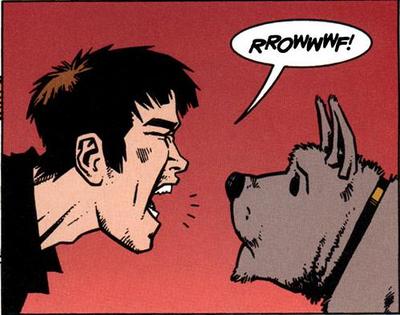
Saturday, July 02, 2005
Pop Comics & the (New) Mainstream
This just in: Top hats are sexy. If I had some kind of weird kink, it would be top hats. They make anything sexier! Look at our friend Zatanna here, from the cover of Seven Soldiers: Zatanna #2:

Now look at this weird old man. Sexy as pie, eh? Well... maybe moldy lemon meringue. Does that get moldy? It does now!

Anyway, what does this have to do with pop comics and the (new) mainstream, you ask? Why, nothing! I shall get to that now. As I mentioned yesterday, Warren Ellis wrote a 'Pop Comics Manifesto' back in '99. I know I've read it before, but it has apparently vanished from the internet. After ages of Googling, I came across an important excerpt on an old Article 10 at Ninth Art, by neat-o-keen Brit comics commentator Paul O'Brien. Here's the excerpt, from Ellis:
"The basic definition of the Pop Comic is a finite, commercially accessible, inventive and intelligent modern comics work. A cultural handgrenade, short, bright and inexpensive. An art bomb, cheap as a single and demanding as much of your time. Three or four issues, or a short original graphic novel... And the Pop Comic is creator owned."
Warren and I seem to share the same ideas, as I was very much interested in writing some of these "pop comics," when I discovered a term had been invented for them. Basically, the ideal format for a pop comics is a "graphic novella." It shouldn't be overly long, no longer than 96 pages, and hopefully it's relatively cheap. If one could produce 80-page pop comics for five or six bucks, that'd be perfect. It's, as Warren says, like a pop music single. People seem to like them, and it's a relatively inexpensive and hopefully totally awesome experience. Ellis has done some pop comics like Ministry in Space, Mek, Toyko Storm Warning, Reload, Two-Step, and Red. I, unfortunately, have read none of these. I hear they were good, though! Look for them in trade paperback format.
A perfect example of a pop comic, and an early one, is Grant Morrison and Philip Bond's Kill Your Boyfriend. Other earlier Morrison works may qualify as 'pop comics' as well: Sebastian O? St. Swithin's Day? The Mystery Play? How about his newer stuff, like the "Seagull Trilogy:" Seaguy, We3, Vimanarama!? Peter Milligan's Rogan Gosh might be a pop comic, too. Anyway, I'm sure all of those are fabulous (I've only managed to read Swithin's, which is like a kooky modern version of Catcher in the Rye, and the "Seagull Trilogy," whi
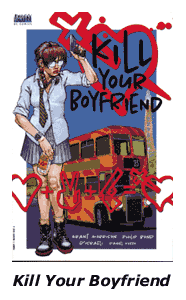 ch you've already heard my thoughts about), but this is about Kill Your Boyfriend, which I shall shorten to KYB, like all the cool kids.
ch you've already heard my thoughts about), but this is about Kill Your Boyfriend, which I shall shorten to KYB, like all the cool kids.KYB is a terrific dark comedy and pop art masterpiece. The official synopsis is this: "Boy meets Girl. Girl falls for Boy. Boy takes Girl on violent rampage through English suburb. Murder, sex, drugs, and anarchy follow." It's very hard to find for purchase, though, as it's out of print for both printings. I suppose you could download it on BitTorrent, where it was available at one time, but that would be "evil," wouldn't it? Apparently, it was written while Grant was on Ecstacy. This does not surprise me. And just for kicks, here is a Random Quote Generator from the comic. It's filled with great and funny quotes.
I suppose I should give this some kind of review. Okay. It's from the creative team and publishing house that brought you Vimanarama!, only this is even better. I know someone on Barbelith said it was the first thing they'd save in case of a fire. Hence, greatness. The book really has to be experienced to be fully appreciated, but I'll tell you a few things. For one thing, the script is sharp, witty, and loaded with sarcastic commentary on teenagers, society, anarchism, and all of that good stuff. There's even a riff on Grant's own Invisibles, although I think this book is pre-Invisibles. Still... then it's a humorous precursor! Whatever. The art, by Bond, is lovely and sharp and pop-y and Girl is very pretty, considering she's made of lines and color. Oh, hell, I'm not doing very well with this, am I? The book is... it's *joycore,* is what it is. I suppose we'll have to settle for a small barrage of panels from the book. Here we go!





I could go on. There are dozens of panels and pages that are beautiful and inspired and filled with love, lunacy, and sheer brilliance. I skipped a lot. Alas, I can't put the entire book on here. You'll have to track it down somehow. I give Kill Your Boyfriend a 9/10, because it warms the devious, twisted cockles.
There are also pop *webcomics,* at least, according to my definition. You can find a couple fantastic ones with the open-source character of Jenny Everywhere (speaking of which, I should write a short Jenny script one of these days). My absolutely favorite Jenny strips, which I believe are truly short little pop webcomics, are by fellow 'Lithers Joe Macare and Nelson Evergreen, and they can be found here, here, and here. They're only a few pages each, and they're brilliant. Well worth your time.
So, right. Pop comics. Awesome little art bombs, medium-sized page count, comics with spines (and I mean that both figuratively and literally... it's not a pamphlet, it's a book with an actual spine!), filled with wonderful ideas. They are meant to be devoured, savored, digested, enjoyed, pored over, reread constantly until they fall apart. They are that amazing musical single you just can't stop listening to. They're somewhere between comic singles (or monthlies, floppies, pamphlets, whatever) and TPBs or graphic novels. I've got ideas for a zillion of 'em. About houseboats, hobos, popes, rock bands, living moons, pirates, ninjas, robots, monkeys, mariachis, pet fire hydrants, love, life, and imagination. Pop comics are new, they're interesting, they're experimental, and most of all, they're hella fun. I want to see more of them in the future, and I may just get my wish.
It seems I've run out of time and space, so in our next episode, we'll get to the actual "New Mainstream" part of this column. Stay tuned, same Bill-time, same Bill-channel!
Friday, July 01, 2005
Jeezum Crow! New Content?!?
So it’s come to my attention that three or so people peruse this blog on occasion, and I’ve let it fall by the wayside, which might disappoint them. Then again, I may have hallucinated them when I was on the Vicodin. (I had a prescription, dammit! Don’t hound me, varlets!)
Anyway, let’s get up to date: It’s been a helluva month, from late May through June! But I’ve survived, and hopefully have a good month-and-a-half of boredom ahead of me. So I’ll do some writing, I guess, which may include this little bloggy-type dealy, though if certain events spring into motion, I may fold this into another website which will have much better content, commentary, and, perhaps, webcomics. Of course, places like Comic Book Galaxy and Millarworld are doing fantastic comics/pop culture commentary right now, so maybe there is no longer a place for my dream. Still, I’d like to give it a go. Also, I’ve got plenty of ideas for a few little Parodyverse ditties, as well, as several premises for pop comics (Warren Ellis originated the term, and I’d link to where I read about it, only I just searched for fifteen minutes and couldn’t find a damn thing. So do your own research, sorry!) that I’d like to write pitches and/or scripts for, sometime. So I’ve a lot to do, and not much time to do it! Which generally means I’ll get nothing done. Go me!
To sum up what’s happened during my long absence, ‘cause I haven’t been around on here since March, unless you count that quick post in May, it all fits into one sentence: “I hate my life.” Naturally, there’s more to it. Let’s see... School ended, stuff happened, I went to social events, I took a vacation with friends, I’ve had my heart broken and my spirit crushed and neither of them are mended yet (let’s put it this way: I can’t listen to Billy Joel music anymore, without getting utterly depressed), and, oh yes, I’m deathly afraid of life and the future. I think that about does it right there, don’t you? Let’s move on.
My God, I just checked: this blog is nearly a year old! That was fast. I’m not so sure “The Lithium Age” is a good name for this one-sided forum anymore, but I don’t care! So it stays, for now, until I start a new, hopefully more regular column somewhere else, where I may come up with something better. It’s not that I don’t believe in the message of the Lithium Age (check the archives, dammit!) but it’s not like I’ve focused on it much.
Let’s do that now, then. What are good comics that are following the standards of the Lithium Age? What’s bringing us into a new age of imagination and quality? I’ll tell you.
1. Grant Morrison’s Seven Soldiers: I could rave about this, and go on and on and on, but I think this column here says everything I want to, only better. It’s good, quality comics, done in a way no other comics have been done before. It’s a huge pile of material, and it’s all new and different. So far I’d say Shining Knight and Zatanna have been the best mini-series (the others being Manhattan Guardian and Klarion the Witch Boy, both of which are very good) so far. Morrison is a pioneer in the comics medium, and he’s the best and most imaginative author working in the field today.
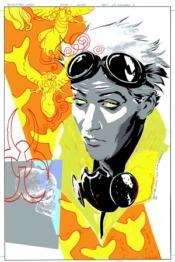 2. Desolation Jones: This is a new book by Warren Ellis and JH Williams III and friends, and it’s a detective book starring a strange, gray-toned man with a trenchcoat, blanket, and gas mask, who lives in LA, which is actually an open prison for ex-spies and the like, and a very weird place indeed. I hope you don’t mind if I basically copy and paste some material I posted over at Barbelith here.
2. Desolation Jones: This is a new book by Warren Ellis and JH Williams III and friends, and it’s a detective book starring a strange, gray-toned man with a trenchcoat, blanket, and gas mask, who lives in LA, which is actually an open prison for ex-spies and the like, and a very weird place indeed. I hope you don’t mind if I basically copy and paste some material I posted over at Barbelith here.
“I found this fresh and fun, in that frightening, dirty way. Heh.
I quite like the premise (and the plot: Hitler porn? Awesome), and Jones himself is an interesting character. The book reads like Marlowe stepped into the maddening horror and perversion of contemporary America. So yes, the writing was pretty good (I was sold halfway through the first page), but that's hardly the major selling point of the book. Rather...
The art: Fantastic. JH Williams III (great name, too) keeps cranking out beautiful comics. The guy's an artiste. The page layouts are always well-done (the two-page spread 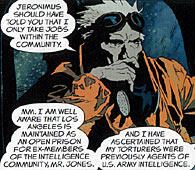 of the eye-gouging... I mean, it's gloriously violent), and the linework is, of course, superb.
of the eye-gouging... I mean, it's gloriously violent), and the linework is, of course, superb.
The lettering: My God, the LETTERING! The lettering is what basically convinced me to pick up the book, and it's marvelous, in the vein of old 50's EC comics.
So, yeah, it's a good comic. I'll be there for #2.”
I’d give the first issue of Desolation Jones a 9/10, because I’m feeling particularly nice. (The image is borrowed from Pipeline at Comic Book Resources. Look at that lettering!)
That’s aboot it, in the true Lithium area. Other comics I’ve picked up lately include Vimanarama (which concluded better than it began, and, while I didn’t fall in love with it, wasn’t really that bad. In fact, I could write a bloody paper on it. I’ll give it a 7/10 overall), Gotham Central (it’s solid as always, but I wish Rucka would write about someone other than Montoya for a change; 7/10), and JLA Classified (Giffen and DeMatteis wrapped up their arc, and it was filled with comedy, drama, heartache, love, action, more comedy, and plenty of irony. Also a 7/10.) Human Target, sadly, has ended, but it was very good (8/10), I dropped Fantastic Four after Waid left (6/10), and Astonishing X-Men gets worse and worse (3.5/10, because I'm mean. Sorry, Joss).
I’m not really a fan of either of the Big Two’s directions right now. Marvel has reached new levels of banality, and the DCU is now a mostly inbred mess of crossovers, with plots that piss me off. I’m sticking to the peripheral stuff, and you should, too.
As for the realm of television, I’ve become addicted to medical dramas now, as I’ve been watching Grey’s Anatomy, House, and ER reruns nonstop. I’m also watching the FBI drama ‘The Inside,’ mainly because a lot of Buffy crew are involved, and it’s not bad, but the ratings are abysmal, so surely it’s doomed. Alas. (I’m surely watching other stuff, but I can’t think of ‘em right now! Haha!)
As for movies, Sin City rocked, Hitchhiker's Guide to the Galaxy was alright, but th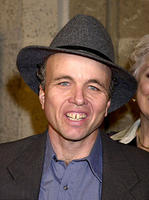 e books are better, and Batman Begins is incredibly awesome. Go see it.
e books are better, and Batman Begins is incredibly awesome. Go see it.
And the Celebrity of the Moment (#3 in a series) is... um... oh, let’s make it Clint Howard. I’ll let the unfamiliar among you do your own homework on this one, but basically he’s Ron Howard’s less famous and uglier brother. And yet he’s still cooler than you. Glavin! (Fear him!)
That’s *plenty* for now. Catch you later. (You know who you are. At least, I hope so. If you’re suffering from amnesia, e-mail me! I’ll be glad to help.)

